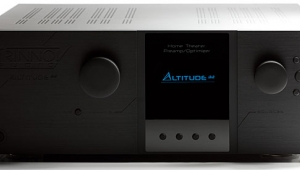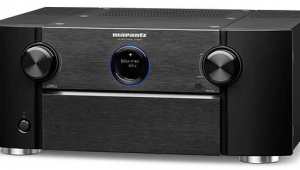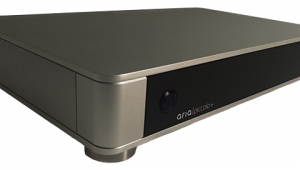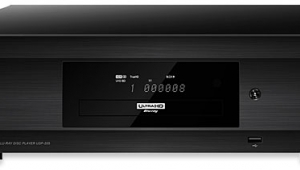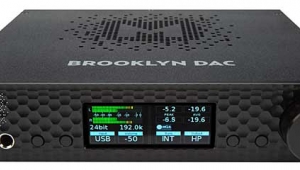| Columns Retired Columns & Blogs |
Music in the Round #19
It seems these days that everybody and his brother is doing something about room equalization. Sure, we had the old-time graphic and parametric EQs—now we're seeing much more sophisticated and dedicated devices, from the TacT and Z-Systems standalone products to the auto-setup and EQ systems found in many A/V receivers. I was impressed with the Audyssey MultEQxt in the Denon AV-4806 receiver—see my "Music in the Round" column in March, p.50—and a standalone AudysseyPro unit was demonstrated at the 2006 Consumer Electronics Show.
Footnote 1: Rhonda J. Wilson, Michael D. Capp, and J. Robert Stuart, Meridian Audio, "The Loudspeaker-Room Interface: Controlling Excitation of Room Modes," AES 23rd International Conference, Copenhagen, 2003.
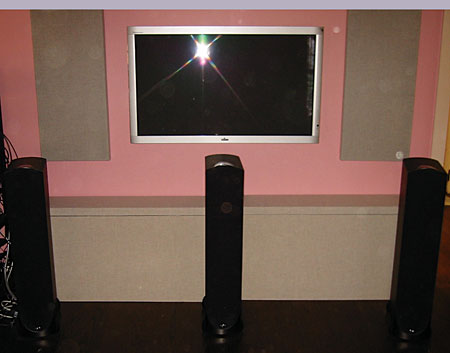
Why has EQ become such a hot topic? No doubt it's partly inspired by the complexity of setup of multichannel home-theater systems, and the limitations many users face when customizing their rooms. The opportunity for new developments in EQ, however, stems from the ubiquity of powerful digital signal processing (DSP) in modern audio and video electronics. For example, Meridian's electronics have been DSP-based for many years; it seems only proper that they should add this powerful and useful feature.
In fact, my main reason for updating my Meridian 861 Reference surround processor to v.4 hardware and v.4.2 software was to take advantage of Meridian Room Correction. The 861 went off to Meridian USA and was back almost before it was missed. However, installation of the upgraded 861 was delayed because, unlike my Manhattan system, my Connecticut system has always been interconnected with unbalanced RCA cables, and the 861's only analog outputs, from its OA13 24/192 boards, are balanced. Because my resident Bryston 9B-ST amp also has XLR inputs, all I now needed were the right wires.
I chose the Kubala-Sosna Fascination XLR cables ($800/first meter, $250/additional meter) because, for the past year or two, I've been very happy with my K-S speaker and power cables. While I was at it, I also replaced the single-ended interconnects from the players with six 1.5m lengths of K-S Anticipation ($350/$125). S/PDIF from all digital sources now runs over K-S Expression digital coax ($925/$200). To complete the rewiring, I added a K-S Emotion power cord ($950) for the Meridian 861. I find the newer K-S cables easier to snake and arrange; their jackets are tighter and sleeker than earlier models, and they make outstandingly secure connections—even the RCAs.
I am no cable fancier; a poorly made cable can definitely screw things up, but the effective range of influence of a good cable on the sound is, in my humble opinion, limited, and somewhat less than that of any other system component. More important is that cables maintain good electrical connections and that the qualities of the components ensure minimal external influence, whether physical or electrical. But now that my Connecticut system is entirely linked with Kubala-Sosna cables, I could not be happier. The K-S cables are among the quietest I've used, almost rivaling the relatively cumbersome JPS SuperConductors in that regard, and they sound transparent, a feature they share with few other competitors. Over all, they seem to get out of the way of everything else and let the system do its thing. For me, that's about the highest recommendation I can make.
Meridian Room Correction
Having installed a 861 Reference into one or another system four times already, I knew to make a map of the system before tackling the electronic setup on the PC. Mirabile dictu, Meridian's new MConfig program replaces pages of configuration options with a drag-and-drop graphic user interface. You can even let it make the most logical connections and associations, or roll your own. New, too, were the guided channel-level settings and room-correction setup routines. But even before I'd attempted any room correction, the upgraded 861 Reference's sound was delightfully and characteristically transparent.
Meridian Room Correction (MRC) is based on these assumptions: 1) the speakers are suitable and flat under anechoic conditions, 2) room problems above 200Hz can be corrected acoustically, with room treatments, without compromise, and 3) using a filter that is simply an inversion of the measured amplitude frequency response will not eliminate the room's huge influence in the time domain. A white paper by Richard Elen on the Meridian website offers some insight into how MRC works, but an AES paper is more informative (footnote 1).
It seems that MRC looks not for frequency response but for the decay of individual frequencies between 20 and 200Hz, and compares these with its assessment of the decay of acoustical energy in the room across a much broader spectrum. In other words, knowing the target or desired RT60 (the time it takes an impulse to decay by 60dB), MRC then finds those frequencies whose RT60 is relatively long, particularly if those frequencies are integer multiples indicating that they are due to room modes. The effect of this is to reduce the decay time of each strong resonant room mode with respect to the average decay time for the room.
The correction scheme is based on calculating and inserting multiple narrow notch filters for each speaker in each of the 861's applications—eg, Music, 2-Channel Movie (Logic), Multichannel Movie—in order to reduce the energy in that narrow band. This means that the MRC notch filters are mathematically configured to match the frequency and time parameters of the resonant modes. Because such modal frequencies are usually also emphasized in the frequency domain (due to the retention of energy), these filters may also flatten the amplitude response—but that seems a concomitant goal, and not the primary one. Because this is an entirely subtractive process, MRC also limits the amount of correction to avoid making an audible change in the immediate and direct sound from the speakers. The criteria for this are based on psychoacoustic studies.
The actual operation is easier done than explained. At first, I was surprised to find that Meridian recommends the RadioShack SPL meter—a simple, uncalibrated device—to measure for room correction. However, MRC is looking for the persistence rather than the amplitude of the signals, and so frequency response per se is not very relevant. I plugged the output of my RS meter into an analog input of the 861 Reference, set it for an appropriate sensitivity range (in my case, 80dB), C-weighting, and slow response, and let the system do its thing.
The whole process took about 10 minutes, after which MRC instructed me to save the measurements and upload the entire configuration to the 861. I had to do it a few times to find the right sensitivity on the SPL meter and to bump up the levels on my subwoofer so that MRC was happy with the power levels and the signal/noise ratio, but the program includes enough hand-holding to make this painless.
Listening to the resulting corrections, which I did before looking at the data, I thought that the 861's characteristic clarity, resolution, and dynamics were improved. These weren't biggies, but they were readily noticeable in A/B comparisons, and greatly appreciated over the long term. As with the Denon-Audyssey system in March, I expected more of a difference, but a close look at the MRC filters told me that there wasn't a lot of correction going on.
Footnote 1: Rhonda J. Wilson, Michael D. Capp, and J. Robert Stuart, Meridian Audio, "The Loudspeaker-Room Interface: Controlling Excitation of Room Modes," AES 23rd International Conference, Copenhagen, 2003.
- Log in or register to post comments


